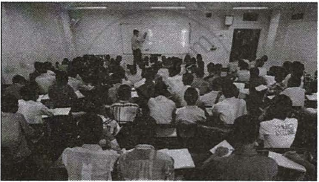Advertisements
Advertisements
Question
Solve for x and y:
x – y = 3, `x/3 + y/2` = 6
Solution
The given system of equations is
x – y = 3 …..(i)
`x/3 + y/2` = 6 ……(ii)
From (i), write y in terms of x to get
y = x – 3
Substituting y = x – 3 in (ii), we get
`x/3 + (x −3)/2` = 6
⇒2x + 3(x – 3) = 36
⇒2x + 3x – 9 = 36
⇒x = `45/5` = 9
Now, substituting x = 9 in (i), we have
9 – y = 3
⇒y = 9 – 3 = 6
Hence, x = 9 and y = 6.
APPEARS IN
RELATED QUESTIONS
Solve for x and y:
2x + 3y = 0, 3x + 4y = 5
Solve for x and y:
`2x - 3/y = 9, 3x + 7/y = 2`
Solve for x and y:
217x + 131y = 913, 131x + 217y = 827
Solve for x and y:
`x + y = a + b, ax - by = a^2 - b^2`
Find the value of k for which the system of equations has a unique solution:
x – ky = 2,
3x + 2y + 5=0.
Find the values of a and b for which the system of linear equations has an infinite number of solutions:
(2a – 1) x + 3y = 5, 3x + (b – 1)y = 2.
The denominator of a fraction is greater than its numerator by 11. If 8 is added to both its numerator and denominator, it becomes `3/4`. Find the fraction.
The present age of a woman is 3 years more than three times the age of her daughter. Three years hence, the woman’s age will be 10 years more than twice the age of her daughter. Find their present ages.
Find the value(s) of p in (i) to (iv) and p and q in (v) for the following pair of equations:
2x + 3y = 7 and 2px + py = 28 – qy,
if the pair of equations have infinitely many solutions.
Read the following passage:
|
A coaching institute of Mathematics conducts classes in two batches I and II and fees for rich and poor children are different. In batch I, there are 20 poor and 5 rich children, whereas in batch II, there are 5 poor and 25 rich children. The total monthly collection of fees from batch I is ₹9,000 and from batch II is ₹26,000. Assume that each poor child pays ₹x per month and each rich child pays ₹y per month.
|
Based on the above information, answer the following questions:
- Represent the information given above in terms of x and y.
- Find the monthly fee paid by a poor child.
OR
Find the difference in the monthly fee paid by a poor child and a rich child. - If there are 10 poor and 20 rich children in batch II, what is the total monthly collection of fees from batch II?

